Steemit Crypto Academy Contest / S15W2: Stock to Flow Model
 |
|---|
INTRODUCTION |
Imagine you have a bucket that is constantly being filled with water and at a certain rate. The stock in this case refers to the amount of water currently in the bucket, whereas the flow represents the rate at which water is being added.
 |
|---|
However what happens if the supply is reduced or even worse there is no water to supply anymore? exactly, the one in the bucket increases in value. This is the idea behind the Stock-to-Flow model.
Explain in your own words the Stock to Flow Model, what is its function? |
|---|
The Stock-to-Flow model is a tool used to predict the future price of a assets. Example of such assets are Gold, Bitcoin etc. This model is used to calculate the ratio or rate of the total amount of the asset (stock) to the amount produced each year or certain interval (flow).
Now, applying this concept to the likes of Bitcoin to explain my point. In the Stock-to-Flow model, the stock of Bitcoin represents the total amount of Bitcoin present in circulation, while the flow represents the rate of production of new Bitcoin units while also considering the permanently removed or destroyed Bitcoin units in the already existing market or the incoming (halving). Hence, the Stock-to-Flow model takes into account the ratio or rate between the existing stock and the flow of new supply and the permanent removal of units.
When I say permanently removed assets or Bitcoin units in the Stock-to-Flow model, I am talking about those Bitcoin units that are taken out of circulation and can't be used anymore. These could be Bitcoins that are lost or destroyed, for example, if someone loses their private key or if a hard drive containing Bitcoins gets damaged. Because these permanently removed assets can affect the overall supply of Bitcoin and can impact on its scarcity and value.
The Stock-to-Flow model suggests that assets with higher Stock-to-Flow ratios tend to have a higher value and are perceived as more scarce. It's a way for people to analyze and predict the potential future value of an asset based on its scarcity.
Meaning assets with a high Stock-To-Flow ratios will have a higher prices than assets with lower ratios i.e. the higher the Stock-To-Flow ratio, the more scarce the asset or the higher number of years required to replenish the current stock based on the adjusted inflow, hence the more likely the asset's price is expected to increase because if the supply is reduced and demand increases or remains constant, price is expected to go up, basic Economics 101.
To calculate the Stock-to-Flow ratio of any asset, we have to consider the current stock with both the new inflow and the permanently removed asset from the market. Hence the formula to carry out the ratio calculation is to divide the existing stock of the asset by the annual flow, taking into account any permanent removals (halving).
i.e.
S2F Ratio = Existing Stock ÷ [(Inflow) - (Permanently removed or destroyed assets)
To highlight my point, let us take a look at an example.
Let me say we have 200 tons of Gold in the world, and every year 50 new tons of Gold is added to the already existing tons, but then, we also permanently lose 20 tons of Gold every year.
To calculate the Stock-to-Flow ratio, we have to account for all Gold in circulation, the inflow and the damaged, hence to do that for our example, we would have to divide the current stock (200 tons) by the adjusted annual flow which is [50 (inflow tons) - 20 (damaged)].
therefore we have:
S2F ratio = 200 Tons ÷ [(50 tons) - (20 tons)]
S2F ratio = 200 tons ÷ 30 tons
S2F ratio = 6.67
Therefore, this indicates that it would take approximately 6.67 years to replenish the current stock of Gold based on the adjusted annual flow.
The Stock-to-Flow model is mostly used by investors to analyze and predict the value of assets such as cryptocurrencies or commodities, based on two main functions:
Scarcity Assessment:
This model helps interested investors assess the scarcity level of an asset by comparing the existing stock (the total amount available) to the annual flow (the newly produced or added amount) while also considering those being lost or destroyed permanently. Therefore, assets with limited supply and higher Stock-to-Flow ratios are deemed to be more scarce, in turn can potentially impact their value.
Value Prediction:
The Stock-to-Flow model is used with the aim to predict the potential value of an asset in the future as it suggests that assets with higher Stock-to-Flow ratios are hoped to have higher price value over time, as they are seen as being more scarce and in demand.
What would be the advantages and disadvantages of the Stock to Flow Model |
|---|
Predictive Power:
The Stock-to-Flow model has shown some ability to predict the future value of certain assets, such as cryptocurrencies or commodities. This is done by considering the scarcity of the asset, hence providing insight into any potential price movements.
Quantitative Analysis:
The Stock-to-Flow model serves as a quantitative stand point for assessing the value of assets as it implies the use of specific ratios and calculations to evaluate scarcity, making it more objective and data driven.
Market Understanding:
By analyzing the Stock-to-Flow ratio, investors and traders get to gain deeper understanding of the market dynamics, hence helping them to assess the supply and demand dynamics of an asset, which in turn leads to them making inform investment decisions.
Long Term Perspective:
The Stock-to-Flow model is particularly useful for long term investors as it focuses on the long term value potential of an asset, by considering the asset's scarcity over time making it a valuable tool for investors who are looking to hold the asset for long term period.
Comparability:
The model also serves as a means for investors to compare different assets as it allows for easy comparison between different assets. Therefore , by calculating the Stock to Flow ratio of different assets, investors get to compare the scarcity and potential value of these various assets, which in turn leads to making sound investment decisions.
Simplified Perspective:
The Stock-to-Flow model focuses primarily on scarcity hence leaving out other important factors that can influence asset prices, such as market sentiment, technological advancements, or regulatory changes.
Uncertain Assumptions:
The Stock-to-Flow model is based on the assumptions that the relationship between stock, flow, and value will remain the same over time, leaving out real life dynamics such as change hence making these assumptions less reliable in predicting future prices accurately.
Limited Historical Data:
The Stock-to-Flow model solely relies on historical data to establish it's patterns and make predictions, therefore if an asset has a limited or inconsistent history or even experiences significant supply changes, it may lead to a decrease accuracy of the model.
Market Manipulation:
The model does mot account for potential market manipulation or external factors that can influence the supply or demand which can disrupt the expected relationship between stock, flow, and value of an asset.
Overemphasis on Scarcity:
The Stock-to-Flow model places a heavy emphasis on scarcity alone, hence emphasizing on it alone may cause overlooking other fundamental aspects that contribute to the value of an asset.
Make an analysis of the Stock to Flow graph, https://www.lookintobitcoin.com/charts/stock-to-flow-model |
|---|
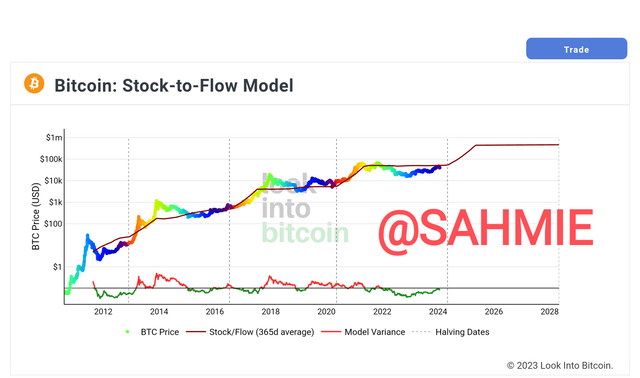 |
|---|
The above diagram is displaying the relationship between Bitcoin stock, flow, and value of an asset.
When looking at the graph, there are certain points where the price of Bitcoin is expected to increase significantly, as this points marks moments where the inflow of new Bitcoin units (FLOW) are reduced, this is known as the halving points as shown below with the Red boxes showing the historical points of the past and the green the prediction of the incoming expectations.
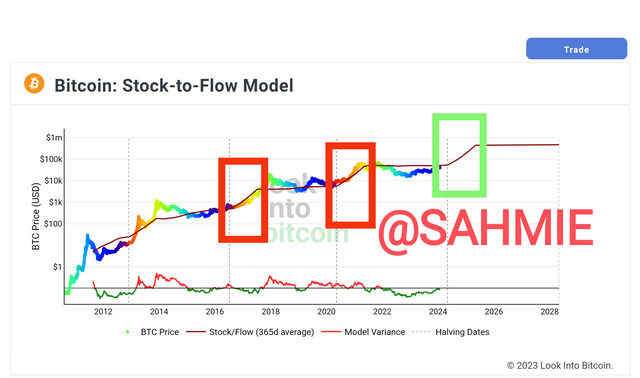 |
|---|
This points serves as the first points of contact with the scarcity, before subsequent days, months or years bringing stability to market sentiment as shown in the image below.
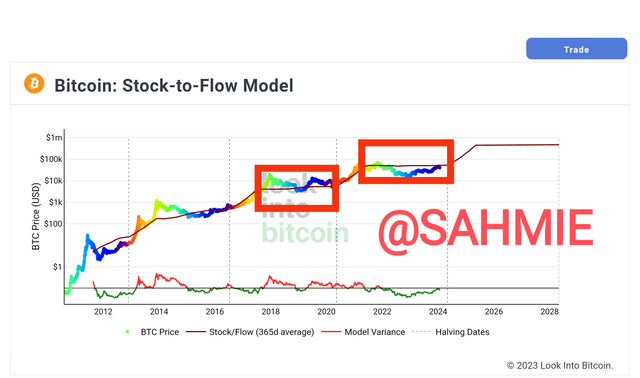 |
|---|
And when we compare the values of Bitcoin on the days of halving, the beginning of scarcity or the day the inflow is reduced with the real market value we can see that it is not far from the predicted values of the Stock-to-Flow model, the screenshots below provides this information.
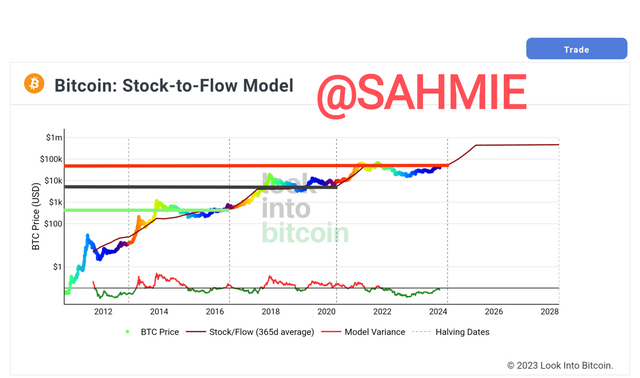 |
|---|
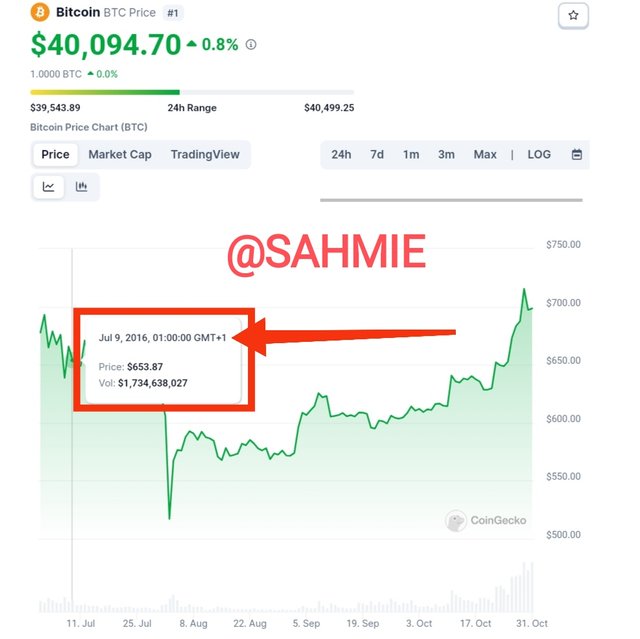 | 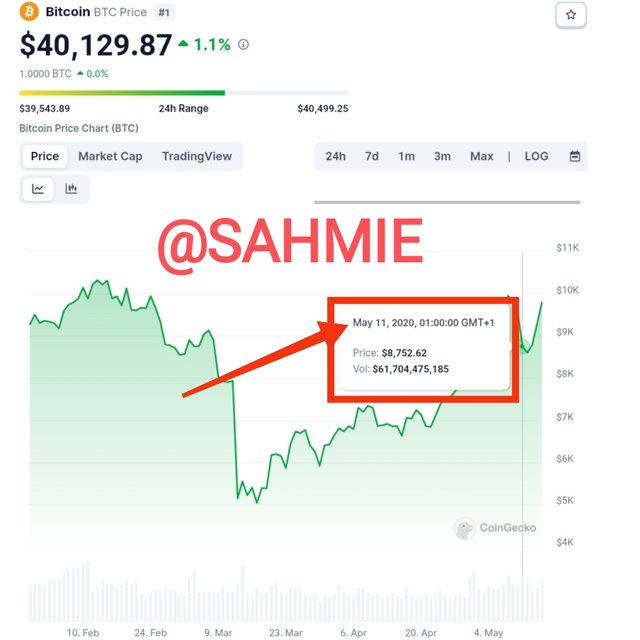 |
|---|---|
Now, looking at the value of one Bitcoin unit as at the days of the last two Bitcoin halvings, we can see that the price of Bitcoin in 2016 (Green Line) and 2020 (Black Line) in the Stock-to-Flow graph is within the range of the on ones in the actual market price as shown in Image A (9th July 2016) and Image B (11th May, 2020) halvings which is around $653.87 as at 1:00 GMT +1 July 9th, 2016 and $8,752.62 as at 1:00 GMT +1 May 11th, 2020.
Therefore if this predictions are something to go by, then the price of a Bitcoin unit come the next halving in April this year, should be around $70k - $80k as shown by the Stock-to-Flow graph (Red Line).
 |
|---|
To which it is still expected to increase like after every other halving in previous years which is predicted by the Stock-to-Flow model to hit over $100k and bring it closer to $1m as shown below, due to the reduced in flow, causing scarcity and with scarcity comes increase in value if demand remains constant or increases.
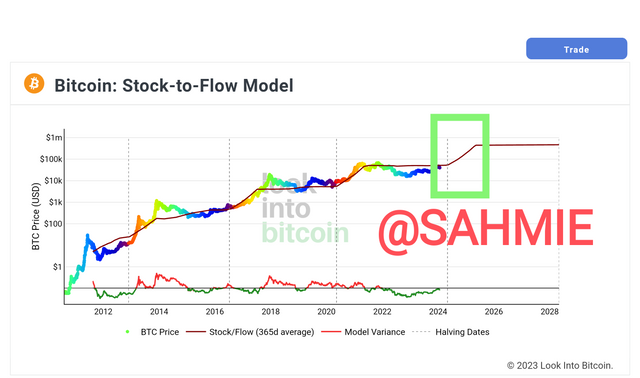 |
|---|
Can this model be applied to STEEM? Give reasons why this Stock to Flow graph model can or cannot be applied. |
|---|
The Stock-to-Flow model is commonly used for assets like precious metals or cryptocurrencies with a limited supply. However, STEEM operates differently as it is a blockchain-based social media platform.
STEEM's value is primarily driven by factors like user engagement, content creation, and network effects, rather than scarcity alone, however this model focuses solely on scarcity hence may not fully capture these dynamics.
While the Stock-To-Flow model is applicable to cryptocurrencies like Bitcoin to estimate its future value, a few limitations exist when applied to STEEM, such limitations include;
Different tokenomics and use case:
While Bitcoin is designed or known as a digital alternative to Gold, unlike other traditional cryptocurrency assets, STEEM was created to serve as incentive to content creation and curation on the STEEM Blockchain. Therefore, unlike Bitcoin a primarily store-of-value asset, STEEM's use case is different, hence applying the Stock-To-Flow model in the same way may not be effective for STEEM.
Community-driven:
The Stock-to-Flow model doesn't account for uncertain market value caused by user adoption or shifts in a digital platform's community sentiment, which may cause unpredictability in the platform's popularity or the number of users.
Limited trading volume:
Limited trading volume for STEEM might indicate more volatility, which might impact the predictive power of the Stock-To-Flow model further.
Complex Ecosystem:
STEEM operates as a blockchain-based social media platform, where the value is derived from user interactions and content creation, however the Stock-to-Flow model does not account for these factors, hence making it less suitable for evaluating the future value of STEEM.
Supply Dynamics:
While STEEM does have a limited supply, the distribution and inflation mechanisms of the token are different from traditional assets making it difficult for Stock-to-Flow model to predict since the model is based on assumptions of a constant relationship between stock, flow, and value, which may not hold true for STEEM.
Market Factors:
The Stock-to-Flow model does not consider market sentiment, technical advancements, or regulatory changes whereas this are factors that can significantly impact the value of STEEM as these external factors are crucial to understanding the dynamics of the STEEM Blockchain and Steemit platform.
But then, even though the Stock-to-Flow model may not be applied directly to STEEM, there are still some possibilities where it could be considered, an this include:
Tokenomics Evaluation:
The Stock-to-Flow model could be used to analyze the scarcity and inflation dynamics of STEEM tokens. Hence, by examining the token supply and flow over time, it may provide insights into the potential value of the tokens.
Comparative Analysis:
Although STEEM operates differently from traditional assets, the Stock-to-Flow model could be used for comparative analysis. By comparing the Stock-to-Flow ratios of STEEM with other cryptocurrencies or assets, it may offer a relative perspective on its value proposition.
Long-Term Trend Assessment:
The Stock-to-Flow model is often used to evaluate the long-term value potential of assets, while it may not capture all the fine details of STEEM value drivers, it could still provide a framework to assess its potential growth and value over time.
However, these possibilities are not definitive applications, but rather ways to explore the potential utility of the Stock-to-Flow model in the context of STEEM.
CONCLUSION |
In conclusion, the Stock-to-Flow model is a cool tool to understand and analyze the historical data of assets calculating the ratio of the asset's scarcity, therefore it is most useful for assets with limited or reducing supply dynamics like Bitcoin. Hence, by using this model, investors can get reliable insights and information that can help them make smart investments decisions and potentially earn profits when trading these assets.
However, it is important to also know that while the Stock-to-Flow model has been successful in analyzing certain assets, it may not be applicable to all assets or situations. Therefore, it is always advisable for investors to consider multiple factors and use it as a tool alongside other analysis methods.
I wish to invite @yakspeace, @ninapenda, @ruthjoe, @drhira and @suboohi
Thank You for your Time
NOTE: Always have a smile on your face, as you are never fully dressed without one.

You have written a very good article, and I really liked it. I clarified many concepts from your article. If you want to see my post, please visit link.
I also have a question for you, If BTC halving did not occur, how would the Stock-to-Flow model work?
Thank you so much for your kind words. I'm glad you found my article helpful and that it clarified many concepts for you.
Now, to answer your question about the Stock-to-Flow model and BTC halving. If BTC halving did not occur, it would have a significant impact on how the Stock-to-Flow model works. The halving event, which happens approximately every four years, reduces the rate at which new Bitcoins are produced. This reduction in supply is a key factor in the Stock-to-Flow model's calculations as it represents some part of the permanently removed or lost units.
Hence, without the halving, the model would not accurately reflect the scarcity of Bitcoin over time because if nothing is being removed or lost, it means the supply remains the same day in, day out meaning equal supply from the first day till the last supply. Just like the bucket analogy, if you keep getting constant and equal supply, will that bring about scarcity? No it won't. So, the halving serves as the point of reducing the supply and making it scarce to potentially push the prize up, because when something is scarce, we tend to appreciate them more.
Hence, the reduction in new supply (halving) plays a crucial role in the model's predictions and the understanding of Bitcoin's value. So, the occurrence of BTC halving is an important aspect to consider when using the Stock-to-Flow model.
I hope this helps? If you have any more questions, feel free to ask.
But then again, not all markets or materials that uses the Stock to Flow Model experiences halving. This is where those destroyed or units permanently removed from circulation or the supply comes in.
That is, without BTC halving, the Stock-to-Flow model for Bitcoin would need to be recalculated or adjusted to account for the constant rate of new supply and the model would likely focus more on the existing stock of Bitcoin and its flow in the market (those in circulation), rather than the reduction in supply over time.
However, it's important to note that the Stock-to-Flow model effectiveness is closely tied to the occurrence of BTC halving, so it would rather be inaccurate because the ratios will be more stable and without drastic changes as shown in those periods between the Halvings in the image above or it will practically inapplicable without the halving.
You're a great teacher
Wow! This is new and it fills me with happiness. Thank you for your compliment, I truly appreciate your kind words. Being called a great teacher is a wonderful compliment, it is my goal is to provide helpful and informative that educates my readers. Like you, I'm here to gain and share knowledge doing it in a way that is easy to understand and relatable. It brings me joy to know that you find my guidance valuable.
Thank you once again and have wonderful days ahead, and lest I forget, welcome to Steemit, I hope to see you achieve all your set out goals.
@sahmie great breakdown of the Stock-to-Flow model! Your explanation about how scarcity influences the value of assets like Gold and Bitcoin is really clear. I appreciate how you connected the model to Bitcoins halving events emphasizing the impact on scarcity. The detailed calculation example for the Stock-to-Flow ratio made it easier to grasp. Best of luck in the contest!
Thank you brother for your kind feedback. I am happy that my explanation of the Stock-to-Flow model made sense to you. It is all about how scarcity affects the value of assets like Bitcoin. And those halving events for Bitcoin, They really emphasize the impact on scarcity. I'm also happy that the detailed calculation example helped you understand the Stock-to-Flow ratio better. Thanks for the well wishes in the contest, I appreciate it and the same to you too.
@sahmie
You really gave a very good example. Imagine a bucket filled with water and you can determine that the water level will decrease, meaning that it is very close to extinction. As you mentioned about the stock-to-flow model and examples of such assets are gold and bitcoin which determines their future price and volatility. Explains to us clearly all the things that are and about stock to flow ratio you have clearly explained to us that the newly introduced stock and the previously disappeared stock should be clearly understood and considered. Should and stock-to-flow investors use it for analysis and pricing in umts. Other posts of yours are admirable, definitely doing a great job and you have clearly shown us in this. But its all things which we clearly understand from main point of view and your post is admirable definitely doing excellent work and my best wishes are with you that you win the competition.
Thank you for your amazing feedback. I am happy to hear that my example simplified the concept for you. Indeed, it is like a bucket of water, right? When the water level gets low, it's close to running out, and people gets to appreciate every drop left. That's how the stock-to-flow model works for assets like gold and bitcoin. It helps determine their future price and volatility by calculating their level of scarcity, hence considering the newly introduced stock and the previously destroyed stock is key. It is awesome that you find my posts admirable and think I'm doing a great job. Your best wishes mean a lot to me, thanks you.
Saludos cordiales gran amigo sahmie, un gusto para mi saludarte y leer tu participación.
Que gran publicación amigo, has abordado cada interrogante de una manera magistral, se nota tu gran conocimiento en el mundo cripto. Te vere en top 3.
Te deseo muchos éxitos, que tengas un feliz y bbendecido día.
Thank you so much for your kind words and support. It is always a pleasure to hear from you and read your encouraging messages. I'm thrilled that you found my publication to be helpful and well-addressed. Your belief in me means a lot. Let's hope for the best and see what happens in the contest. Wishing you a successful and blessed day as well.
Upvoted! Thank you for supporting witness @jswit.
You've provided a clear and insightful explanation of the Stock-to-Flow model. Your analogy of the bucket being filled with water effectively illustrates the concept, making it easier to understand.
Well done!
Thank you so much for your kind words and feedback. I am really glad that my explanation of the Stock-to-Flow model resonated with you. Comparing it to a bucket being filled with water was my way of making it easier to understand. I appreciate your support and encouragement. Thanks again, and keep up the great work.
Greetings, my friend @sahmie! Your Stock-to-Flow breakdown is osm. The bucket analogy simplifies complex concepts, making it ABC-easy to grasp. All the best in the contest, success for you! 👍
Thank you so much for your kind words and support. I'm glad you found my breakdown of the Stock-to-Flow model to be osm (awesome). Using the bucket analogy was my way of simplifying the complex concepts and making them ABC-easy to grasp. I really appreciate your well wishes for the contest. Best of luck to you too, may success come your way.
Upvoted. Thank You for sending some of your rewards to @null. It will make Steem stronger.